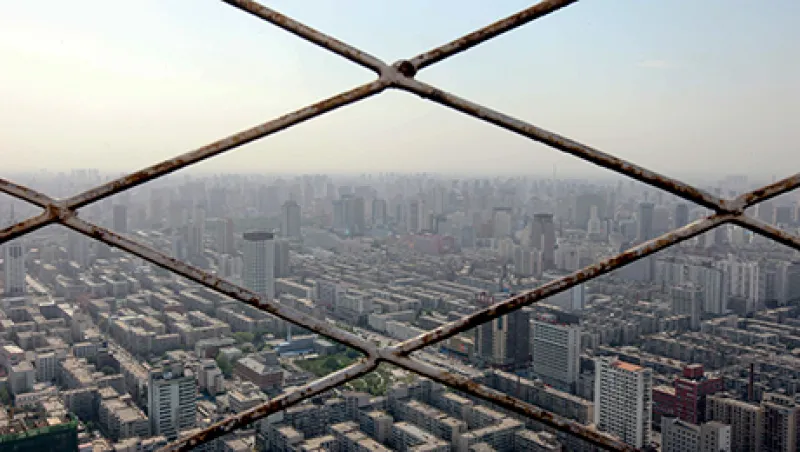When the tide goes out, as Warren Buffett once said, you can see who’s naked. China is no exception.
With the country’s hyper growth slowing significantly, a huge army of zombie enterprises has emerged. These heavily indebted companies are kept afloat only by continuous support from the government and banks.
The authorities act because they fear rampant unemployment and lost tax revenue; the banks lend a hand because they do not want to take provisions for bad debts and see their earnings fall. Lenders also hope there will be a market rebound soon. But unfortunately, things may get worse. Zombie enterprises are holding back economic recovery in China, preventing the reallocation of resources to more productive businesses and tilting the playing field toward the less fit.
Closing companies with overcapacity is a priority of the government’s supply-side reform strategy, but first we need to figure out how many zombie enterprises there are.
We used the China listed company database to screen for businesses that are losing money but can borrow at a price below the market rate. The unique characteristic of zombie enterprises is that the more they are losing, the more they can borrow — that’s the only way they can survive. We found that roughly 10 percent of listed companies in China are walking dead. This is probably an underestimation of the scale of the problem, because if a company can be listed in China’s stock market, it should be more competitive than its peers.
Soon after the global financial crisis, the number of zombie enterprises increased sharply. Then in late 2008 the government adopted a 4 trillion renminbi ($600 billion) stimulus policy, which helped to boost growth and give these companies breathing space. The number of zombie enterprises dropped slightly, then resumed rising when China’s growth rate slowed, until finally the problem of zombie companies has become more difficult to hide and ignore.
Zombie enterprises cluster in industries burdened by debt and overcapacity, like iron and steel, aluminum and cement. Because the government always wants to protect jobs, labor-intensive industries such as textile, paper and food processing are also home to many zombies. The property sector deserves close scrutiny because so many empty apartments have been built and developers have had a difficult time reducing their inventory. Although the real estate sector does not have the highest ratio of zombie enterprises, it does make up a large share of Chinese listed companies.
State-owned enterprises also have a higher propensity to turn into zombies. After several years of losses, private enterprises have no way to continue and have to shut down. SOEs, however, can keep getting fresh credit from the banks.
Drawing a line from the northeast to the southwest, we find the new rust belt in China. Heilongjiang and Liaoning in the Northeast, Shanxi on the Loess Plateau, Hebei on the North China Plain and Hunan in the Yangtze Basin are the regions most haunted by zombie enterprises. They are either resource-rich areas (such as Shanxi and Hunan) or smokestack-heavy industrial bases (like Heilongjiang, Liaoning and Hebei). These less economically diverse areas are the most vulnerable to slowing growth and falling commodity prices.
The greatest obstacle to shutting down or scaling back zombie enterprises is fear of mass layoffs, which the government worries could lead to social instability. The leadership has announced the establishment of a 100 billion renminbi fund to assist the new jobless. Is it enough?
We looked at six industries that have the greatest overcapacity: steel, coal, cement, glass, paper and nonferrous metals. We assumed the capacity utilization rate should be adjusted to 80 percent, a reasonable level by international standards. We also assumed that if capacity is downscaled by, say, 10 percent, employees will be reduced in the same proportion. Then we looked at the minimum wage level of different industries and provinces to estimate compensation for laid-off workers.
According to our calculations, about 4.31 million workers will become redundant in these sectors: 950,000 in steel, 1.22 million in coal, 440,000 in paper, 1.38 million in cement and glass, 320,000 in nonferrous metals. The cost of helping these new jobless will range from 163.76 billion to 491.25 billion renminbi, depending on how generous the government wants to be.
The government is hesitant to swallow the pill of factory closures and employee layoffs. It thinks merging zombie enterprises can reduce their number and rolling over or restructuring loans can buy time. These policies may seem less disruptive, but they will exacerbate the problems of overcapacity and high debt. Combining ailing companies will only create giant zombies, and debt–equity swaps may simply trade zombie enterprises for zombie banks. There is no solution without pain and cost. It’s the time to take the medicine and feel the pain.
Fan He is chief economist of the Chongyang Institute for Financial Studies at Renmin University of China and senior research fellow of Institute for New Economic Thinking.






